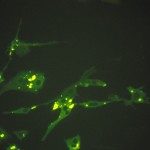Link to Pubmed [PMID] – 20107019
J. Gen. Virol. 2010 May;91(Pt 5):1262-74
The genus Hantavirus (family Bunyaviridae) includes negative-strand RNA viruses that are carried by persistently infected rodent and insectivore species. Puumala virus (PUUV), carried by bank voles (Myodes glareolus), is a pathogenic hantavirus that causes outbreaks of mild haemorrhagic fever with renal syndrome across Europe. In northern Europe, PUUV is represented by several genetic lineages that are maintained by distinct phylogroups of bank voles. The present study describes sequences of new PUUV strains recovered from northern and southern regions of Scandinavia and compares phylogenetic relationships between north-European PUUV strains and M. glareolus. This analysis revealed contradictions in phylogenetic clustering and remarkable differences in estimated divergence times between the lineages of PUUV and its host, suggesting that the established PUUV lineages did not co-diverge with the distinct phylogroups of M. glareolus that carry them at present.

